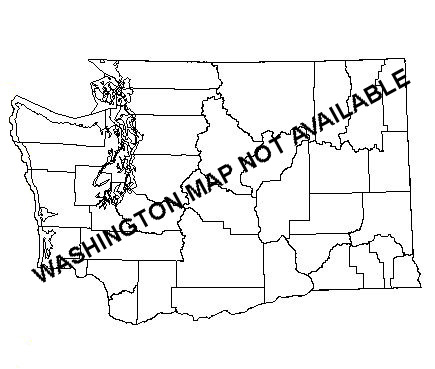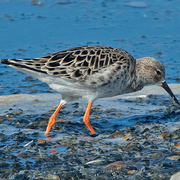Ruff
General Description
Male Ruffs are highly distinctive in breeding plumage, although that is not generally the plumage that we see when this Eurasian shorebird visits Washington. The adult male varies in color from dark rufous to light brown with considerable white. It has a thick mane of long feathers around its neck and thick head-feathers that can be puffed out. The female, called a Reeve, is mottled brown-and-buff with orange legs (sometimes olive or green). Females and males in non-breeding plumage appear similar, and both have orange bills with white feathers at the bases. The female is about the size of a dowitcher, and the male is similar in size to a Greater Yellowlegs. The juvenile, the form most likely to be seen in Washington, has lighter, more yellow legs than adults. Its breast is clear buff, and its belly grades from buff to white. The head is buff and mostly unstreaked, and the back is black edged with buff. In flight, the Ruff shows a white 'U' on its tail, separating a dark rump and dark tail-tip.
Habitat
Ruffs breed in sub-Arctic and Arctic tundra meadows in northern Europe and Siberia. They winter primarily in similar open, wetland habitats in southern Europe and Africa, and to a lesser degree in southern Asia and Australia. During migration, they can be found in these habitats as well as coastal ponds, lagoons, estuaries, and mudflats. These coastal wetlands are the Washington habitats where Ruffs are most likely to be spotted.
Behavior
In fresh water, Ruffs are often seen wading up to their bellies, but in salt water they usually stay above the shoreline, in habitat similar to that used by Pectoral Sandpipers. They walk or run at a steady pace, with their heads up, picking food from the substrate. They also sometimes probe in the mud and walk slowly through vegetation with their heads down.
Diet
Ruffs eat a typical shorebird diet of insects and other invertebrates. During migration and winter, they may also eat seeds.
Nesting
Male Ruffs gather into groups in concentrated areas called leks, to display and attract females. The female comes to a lek and chooses a male. The female mates with a male and then leaves the lek. As is typical in this type of mating, the male provides no parental care. The female builds her nest on the ground, hidden in grass or marsh vegetation. The nest is a shallow depression lined with grass. She lays four eggs and incubates them for 20 to 23 days. The female feeds the newly hatched young, which is unusual for this group. The young first begin to fly at 25 to 28 days.
Migration Status
Ruffs, Eurasian shorebirds, are long-distance migrants. They typically breed from northern Europe to Siberia and winter in southern Europe and Africa, but they regularly wander off-course from their migration routes and appear on both coasts of North America, especially during the fall.
Conservation Status
Loss of wetland habitat has contributed to a decline in the population in some parts of Europe. Here in Washington, the Ruff is one of the most numerous Siberian shorebirds seen on our coast. Its range may have expanded into North America, as there is evidence of a small breeding population of a few dozen birds in Alaska.
When and Where to Find in Washington
In Washington, these rare but regular visitors are generally found singly or occasionally in pairs. Most of the birds spotted in Washington are juveniles, and they are most likely to be seen in August and September. Over half of the Ruff records in Washington are from Ocean Shores (Grays Harbor County). Ruffs have also been spotted in Aberdeen (Grays Harbor County) and Reardan (Lincoln County). There are a few spring records from the Vancouver, BC area, and one spring record from St. Andrews, WA (Douglas County).
 Abundance
Abundance
| Ecoregion | Jan | Feb | Mar | Apr | May | Jun | Jul | Aug | Sep | Oct | Nov | Dec |
|---|---|---|---|---|---|---|---|---|---|---|---|---|
| Oceanic | ||||||||||||
| Pacific Northwest Coast | R | R | R | |||||||||
| Puget Trough | R | R | R | |||||||||
| North Cascades | ||||||||||||
| West Cascades | ||||||||||||
| East Cascades | ||||||||||||
| Okanogan | ||||||||||||
| Canadian Rockies | ||||||||||||
| Blue Mountains | ||||||||||||
| Columbia Plateau |
Washington Range Map

Family Members
 Spotted SandpiperActitis macularius
Spotted SandpiperActitis macularius Solitary SandpiperTringa solitaria
Solitary SandpiperTringa solitaria Gray-tailed TattlerTringa brevipes
Gray-tailed TattlerTringa brevipes Wandering TattlerTringa incana
Wandering TattlerTringa incana Greater YellowlegsTringa melanoleuca
Greater YellowlegsTringa melanoleuca WilletTringa semipalmata
WilletTringa semipalmata Lesser YellowlegsTringa flavipes
Lesser YellowlegsTringa flavipes Upland SandpiperBartramia longicauda
Upland SandpiperBartramia longicauda Little CurlewNumenius minutus
Little CurlewNumenius minutus WhimbrelNumenius phaeopus
WhimbrelNumenius phaeopus Bristle-thighed CurlewNumenius tahitiensis
Bristle-thighed CurlewNumenius tahitiensis Long-billed CurlewNumenius americanus
Long-billed CurlewNumenius americanus Hudsonian GodwitLimosa haemastica
Hudsonian GodwitLimosa haemastica Bar-tailed GodwitLimosa lapponica
Bar-tailed GodwitLimosa lapponica Marbled GodwitLimosa fedoa
Marbled GodwitLimosa fedoa Ruddy TurnstoneArenaria interpres
Ruddy TurnstoneArenaria interpres Black TurnstoneArenaria melanocephala
Black TurnstoneArenaria melanocephala SurfbirdAphriza virgata
SurfbirdAphriza virgata Great KnotCalidris tenuirostris
Great KnotCalidris tenuirostris Red KnotCalidris canutus
Red KnotCalidris canutus SanderlingCalidris alba
SanderlingCalidris alba Semipalmated SandpiperCalidris pusilla
Semipalmated SandpiperCalidris pusilla Western SandpiperCalidris mauri
Western SandpiperCalidris mauri Red-necked StintCalidris ruficollis
Red-necked StintCalidris ruficollis Little StintCalidris minuta
Little StintCalidris minuta Temminck's StintCalidris temminckii
Temminck's StintCalidris temminckii Least SandpiperCalidris minutilla
Least SandpiperCalidris minutilla White-rumped SandpiperCalidris fuscicollis
White-rumped SandpiperCalidris fuscicollis Baird's SandpiperCalidris bairdii
Baird's SandpiperCalidris bairdii Pectoral SandpiperCalidris melanotos
Pectoral SandpiperCalidris melanotos Sharp-tailed SandpiperCalidris acuminata
Sharp-tailed SandpiperCalidris acuminata Rock SandpiperCalidris ptilocnemis
Rock SandpiperCalidris ptilocnemis DunlinCalidris alpina
DunlinCalidris alpina Curlew SandpiperCalidris ferruginea
Curlew SandpiperCalidris ferruginea Stilt SandpiperCalidris himantopus
Stilt SandpiperCalidris himantopus Buff-breasted SandpiperTryngites subruficollis
Buff-breasted SandpiperTryngites subruficollis RuffPhilomachus pugnax
RuffPhilomachus pugnax Short-billed DowitcherLimnodromus griseus
Short-billed DowitcherLimnodromus griseus Long-billed DowitcherLimnodromus scolopaceus
Long-billed DowitcherLimnodromus scolopaceus Jack SnipeLymnocryptes minimus
Jack SnipeLymnocryptes minimus Wilson's SnipeGallinago delicata
Wilson's SnipeGallinago delicata Wilson's PhalaropePhalaropus tricolor
Wilson's PhalaropePhalaropus tricolor Red-necked PhalaropePhalaropus lobatus
Red-necked PhalaropePhalaropus lobatus Red PhalaropePhalaropus fulicarius
Red PhalaropePhalaropus fulicarius

